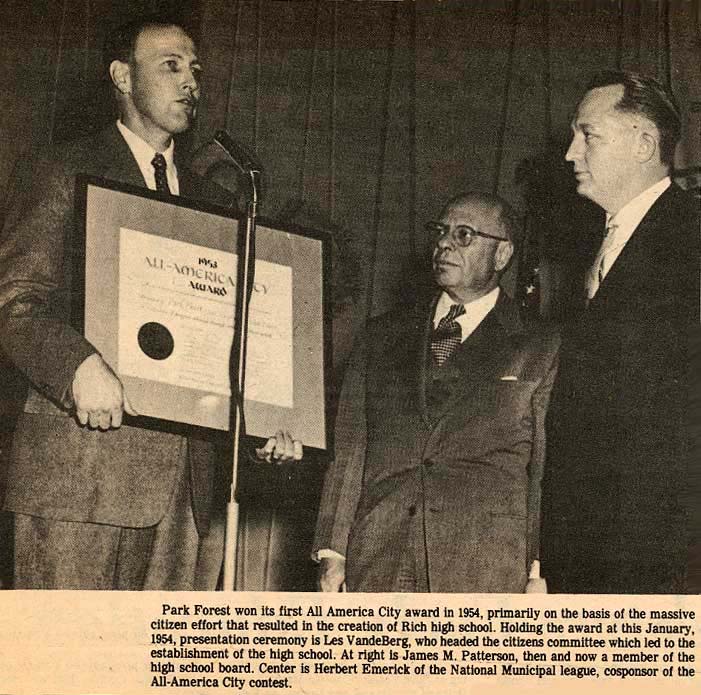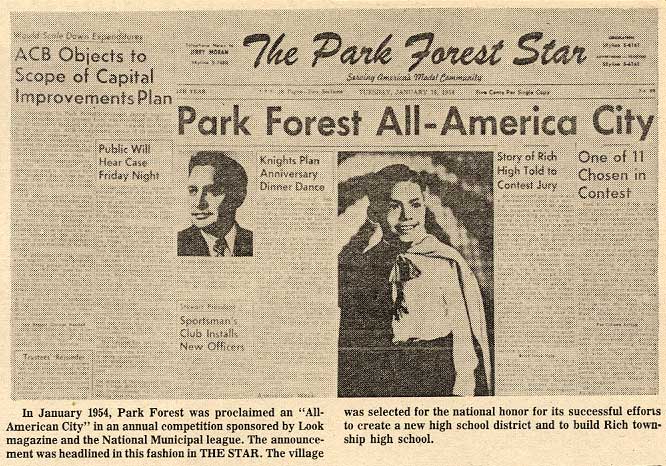For the Creation of Rich High School

The photograph above appeared in the Park Forest Star, June
2, 1977, in a Commemorative Edition on the
occasion of Park Forest winning its second All-America City Award.
Used with permission from The Star.

The photograph above appeared in the Park Forest Star, June
2, 1977, in a Commemorative Edition on the
occasion of Park Forest winning its second All-America City Award.
Used with permission from The Star.
The application below, written by James M. Patterson, a member of the first School Board, for the All-America Cities Award was submitted in late 1953 to the Municpal League of Richmond, Virginia, and the award was won for Park Forest in January of 1954. The application was found in the archives of the Park Forest Public Library and is used with permission from the library. Following the application, there is a summary of how the award was won.
(APPLICATION) Park Forest, Illinois
PARK FOREST, a brand-new city in Chicagoland now has a population of 20,000 and a fine Township High School serving the community and the surrounding area of Rich Township. In the "pioneer" days of 1950 and 1951, virtually everyone was in agreement about the need for new elementary schools. Not so when it came to a high school for Rich Township! Many of the older residents -- mostly farmers and residents of the small neighboring villages of Matteson, Richton Park and Olympia Fields -- resented the newcomers and the problems they created.
The situation was complicated by the fact that 40% of the new village was in nearby Bloom Township necessitating a special "change of boundary." About 50 volunteers took a house-to-house census of an area with 5,000 residents. Petitions were circulated and filed in the record time of 10 days. The district boundaries were settled in the Spring of 1951, and the school bond election was scheduled for June 23.
In Park Forest, 105 citizens volunteered to get out the vote. The result in Park Forest: the largest vote in village history and a majority of more than 99%. This overwhelming support more than offset opposition in the remainder of the district and accounted for a 4 to 1 over-all victory.
Before the bonds could he sold, new state legislation dissolved the district on the grounds that it was not operating a school. Again, local citizens came forward. An injunction was secured in the Circuit Court. The case was fought through the Illinois Supreme Court in record time. The higher court upheld the validity of the school district. This made it possible to sell bonds in the spring of 1952 and to begin construction of its new school that fall.
At this time, a new volunteer committee of 100 lay citizens, sponsored by the Board of Education, led the way in planning the type of educational program wanted for the teenagers of this district, and in making recommendations as to the kind of High School building and staff needed to carry out such a program.
The committee's first step was to circulate a questionnaire which invited thousands of family groups to tell the Board of Education what they wanted the school to be and to do. Members of major subcommittees on curriculum studied all sorts of educational materials, visited other schools, and conferred with leading educational consultants.
Results indicated that the original bond issue would not provide the facilities desired. Accordingly, news bulletins were prepared and distributed, town meetings scheduled, and a referendum held April 12,1952, made available a total of $1,600,000 for the new school. House-to-house work, speeches and publicity by the citizens' committee resulted, for the first time, to a favorable vote in every precinct.
With the immediate task accomplished and construction under way, the citizens did not rest on their laurels. Since November 1952, a well-organized citizens’ committee of a permanent nature has dedicated itself to the improvement of educational service within the district. On September 14, 1953, the doors opened for 500 high school students in a modern, functional building housing a competent faculty and offering a curriculum tailored to local needs. All this was made possible through the organized efforts of 292 lay citizens spending 6,590 hours on behalf of the school. Volunteers are still doing yeoman service as a representative advisory body. The soundness and effectivenee of local school planning and operating policy is thus insured.
James M. Patterson
Board of Education
Rich Township High School
The following
is a summary of how Mr. Patterson and others achieved the All-America Cities
Award
for the creation of Rich Township
High School, based on Mr. James M. Patterson's Oral History
transcript of December 9, 1980,
and used with permission from the Park Forest Public Library:
American Community Builders built an excellent housing project. But developers cannot build All-America cities; it’s people who build All-America cities. They are the indispensable ingredient. From the 1948 beginning, Park Forest residents were young marrieds, the husband typically a WWII veteran and a professional man, salesman, engineer, etc. Most were college graduates, and the typical wife had also attended two or more years of college. The village had proportionally more Ph.D.s than any town in the United States. The young families were sociable, friendly and wanted to have a good time and a good home. They not only wanted a good community, but they were willing to work hard for it.
One of the great things about Park Forest in the early years were the informal parties that would develop in the rental courts on an evening or weekend. One Friday evening late in 1953, a court party started in Court E-7, where Mr. Patterson lived. A neighbor, Jack Starr, who was the Midwest editor of LOOK magazine, began teasing Patterson about an article that had been critical of the high school, and asked if he was the “High Priest of the New Illiteracy.” Patterson became sufficiently irritated to respond: “You don’t know what the hell you’re talking about,” and proposed to explain the story of the high school to him the next morning. And on Saturday morning, he took Mr. Starr for a tour of the high school facilities, and explained the program and described how the school had been created by a 100 % volunteer citizens’ effort. The first employee had not been hired until the bond issue referendum was passed.
Mr. Starr was so impressed with the explanation that he told Mr. Patterson: “You ought to enter this in the All-America Cities contest, but there is one problem - the entries close tonight at midnight.” Patterson responded: “Well, Jack, since LOOK is a fifty-fifty sponsor with the Municipal League, and you are an employee, could you receive the thing before midnight and stamp it as being in on time?” Starr said he could do that, and so Patterson went home and sat down at his typewriter and wrote out the Park Forest entry and handed it over to Mr. Starr.
The entry told the story of the village’s strong citizen participation and volunteer efforts to create the high school district, establish the high school, and then get it built. Mr. Patterson knew the story by heart, for he had actively participated in every step of the process. He had been named the head of the high school committee by the Community Council which had been set up even before Park Forest had become a legal jurisdiction. He became the Park Forest representative on the first School Board, elected in April, 1949.
Park Forest was one of 122 entries in the competition. It survived the initial screening of the applications, and in late 1953, Mr. Patterson was invited to Richmond, Virginia, for an interview with the jury. He had just been treated at St. James Hospital for bursitis in an elbow and had his arm in a sling. Before leaving for Richmond, he bought a black silk scarf to replace the white sling the hospital had provided. Upon arriving in Richmond, Patterson met Jack Starr to discuss the strategy of his presentation to the jury, which was chaired by George Gallup, and included other distinguished citizens and members of the Municipal League. Patterson was convinced that all the communities in competition were meritorious, and that merit alone could not determine the winners. For example, the competition included Pittsburgh, for the revitalization of the downtown, and Canton, Ohio, and Peoria, Illinois, both for the cleaning up of red-light districts. Hoping to be well-remembered by the Jury, Patterson toyed with the idea of adding an eye-patch to his arm sling, but decided that would be going too far. He chose the technique of bringing each member of the jury into his presentation. For example, he brought in George Gallup by saying: “Like Dr. Gallup, we were interested in public opinion, but unlike Dr. Gallup, we did not sample. We interviewed every taxpayer in the township. We called door-to-door to find out what kind of school they wanted, how many children they had, what classes they would like to have them in, and that sort of thing.” For Mrs. Houghton, the Chair of the Republican Women’s Committee, he said, “Mrs. Houghton would be interested in the fact that our school was dedicated by Oveta Culp Hobby, the first Secretary of HEW, and the only woman member of Eisenhower’s cabinet.”
His submission and the interview were sufficiently convincing -- and well-remembered -- for the village of Park Forest to be selected as an All-America City! And it surprised Patterson, for he had not expected it. As he said, “I didn’t really think we were going to win. I thought the competition was too tough.” And he had not told anyone of the application, for “ I figured if I didn’t tell anybody, no one would be disappointed. And if we did win, there would be time enough to tell everyone.”
But it was a big surprise for others, and Village President Henry Dietch was receiving telegrams from Vice President Nixon, Governor Stratton, Senator Dirkson, and many others before he was informed that Park Forest was even in the running!
The celebration of the All-America City award was held during the fifth anniversary celebration of Park Forest in January 1954. As Mr. Patterson recalled, “Phil Klutznick made an inspiring speech for us. The entertainment featured the Singing Rockets of Rich High, under the direction of Jay Hoel.”

Front page of The Park Forest Star, January 16, 1954, announcing
the award.
Used with permission from The Star Newspapers.
All World Rights Reserved. Copyrighted ©2002-2003, Rich Township High School Class of 1956